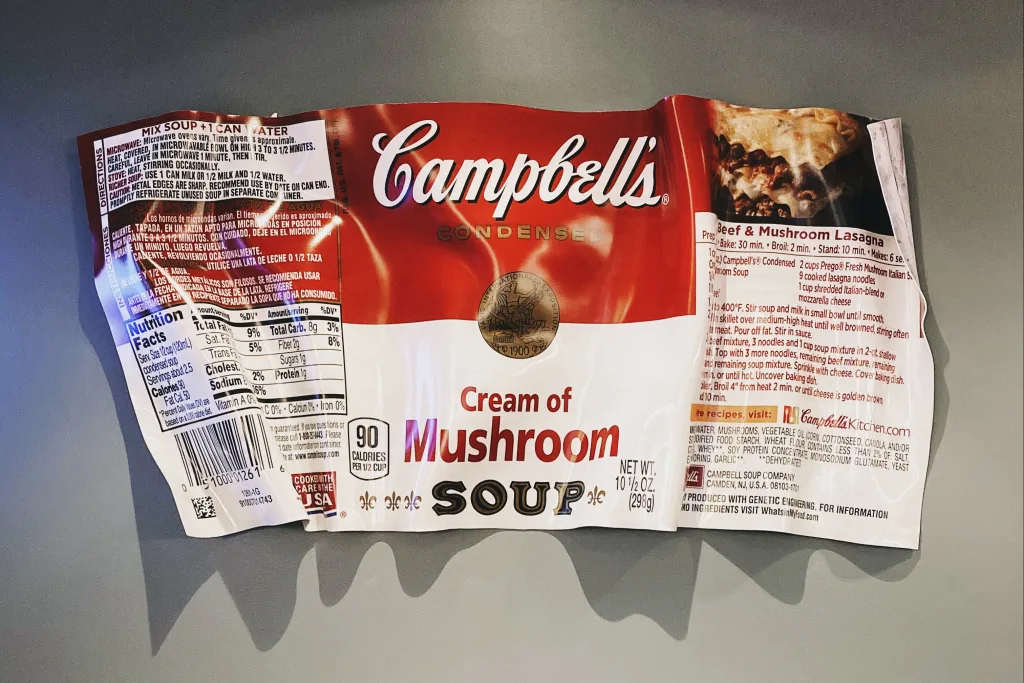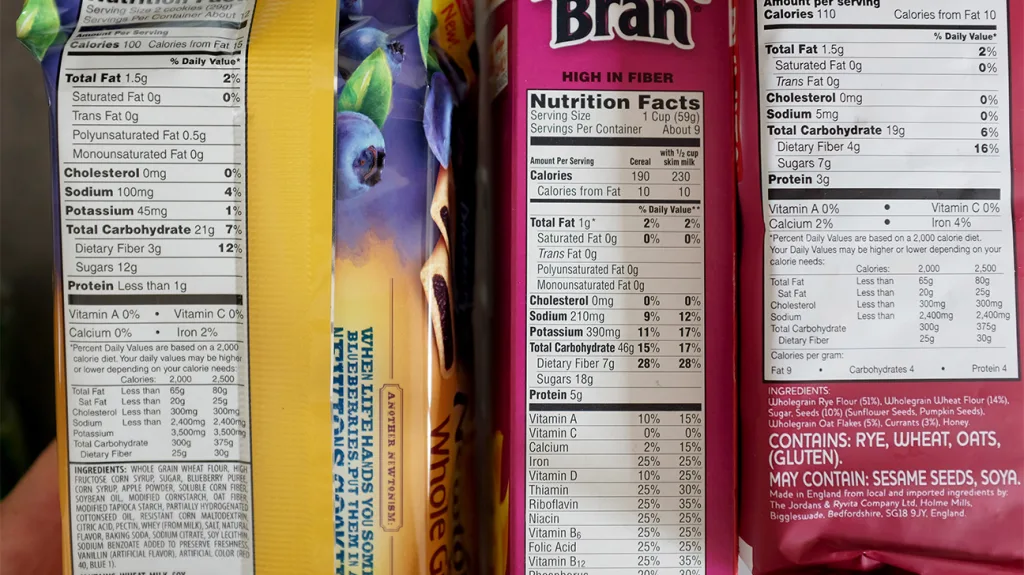When it comes to maintaining a healthy diet, understanding macronutrients is crucial. These essential nutrients provide the energy and building blocks our bodies need to function properly. Macronutrients are divided into three categories: carbohydrates, proteins, and fats. In this article, we will delve into the role of each macronutrient and explore where they are located on a nutritional label.
1. Carbohydrates:
Carbohydrates are the body’s primary source of energy. They are found in foods such as grains, fruits, vegetables, and dairy products. Carbohydrates are further categorized into two types: simple and complex. Simple carbohydrates, like sugar and honey, are quickly absorbed by the body and provide a rapid burst of energy. Complex carbohydrates, such as whole grains and legumes, take longer to digest and provide a steady release of energy.
On a nutritional label, carbohydrates are typically listed under the “Total Carbohydrates” section. This includes both simple and complex carbohydrates. It is important to note that not all carbohydrates are created equal. The label may also provide information on dietary fiber and sugars, which are subsets of carbohydrates. Fiber is a type of carbohydrate that aids in digestion and helps maintain healthy blood sugar levels. Sugars, on the other hand, should be consumed in moderation as excessive sugar intake can lead to various health issues.
2. Proteins:
Proteins are essential for building and repairing tissues, as well as producing enzymes and hormones. They are primarily found in animal products such as meat, poultry, fish, and dairy. Plant-based sources of protein include legumes, nuts, and tofu. Proteins are made up of amino acids, which are the building blocks of our body’s cells.
On a nutritional label, protein content is typically listed under the “Protein” section. It is often measured in grams and provides an indication of the amount of protein per serving. Choosing protein-rich foods can help promote muscle growth, boost metabolism, and keep you feeling fuller for longer.
3. Fats:
Contrary to popular belief, fats are an essential part of a healthy diet. They provide energy, assist in nutrient absorption, and help protect vital organs. Fats are found in various foods such as oils, nuts, seeds, avocados, and fatty fish. There are different types of fats, including saturated fats, unsaturated fats, and trans fats.
On a nutritional label, fats are listed under the “Total Fat” section. This includes both saturated and unsaturated fats. Saturated fats, commonly found in animal products and some plant-based oils, should be consumed in moderation as they can increase cholesterol levels. Unsaturated fats, on the other hand, are considered healthier options and can be found in foods like olive oil, nuts, and fatty fish. Trans fats, which are artificially created through a process called hydrogenation, are often found in processed foods and should be avoided as much as possible.
Understanding macronutrients and their location on a nutritional label is essential for making informed dietary choices. By paying attention to the carbohydrate, protein, and fat content, you can ensure that your body receives the necessary nutrients for optimal health. Remember to prioritize whole, unprocessed foods and strive for a balanced diet that includes a variety of macronutrients.
What Are The Macronutrients On A Nutrition Label?
On a nutrition label, macronutrients refer to the types of foods that are listed and measured in larger quantities. These are essential for providing energy and supporting various bodily functions. The macronutrients typically found on a nutrition label include:
1. Carbohydrates: These are the body’s primary source of energy and include sugars, starches, and fiber. They provide fuel for the brain, muscles, and other organs. Carbohydrates are often categorized as total carbohydrates, which include both simple and complex forms.
2. Proteins: Proteins are essential for building and repairing tissues, as well as supporting the immune system. They are made up of amino acids and play a crucial role in various physiological processes. The amount of protein listed on a nutrition label represents the total protein content in the product.
3. Fats: Fats provide energy, help absorb fat-soluble vitamins, and contribute to cell structure. They are categorized into different types, such as saturated fats, trans fats, monounsaturated fats, and polyunsaturated fats. The total fat content is usually listed on the label, along with the breakdown of different types of fats.
4. Cholesterol: Cholesterol is a type of fat found in animal-based foods. It is essential for hormone production and cell membrane function. The cholesterol content is often listed under the total fat section on the nutrition label.
5. Fiber: Fiber is a type of carbohydrate that is not digested by the body. It plays a crucial role in maintaining a healthy digestive system, promoting regular bowel movements, and reducing the risk of certain diseases. The fiber content is listed separately on the nutrition label.
6. Water: Although not always listed on a nutrition label, water is an essential macronutrient. It is vital for hydration, regulating body temperature, and facilitating various physiological processes.
It’s important to note that the quantities and percentages of these macronutrients may vary based on the specific product and serving size. Reading and understanding nutrition labels can help individuals make informed dietary choices and meet their nutritional needs.

How Do You Identify Macronutrients?
Macronutrients can be identified by understanding their specific characteristics and sources. Here are some key points to help identify each macronutrient:
1. Carbohydrates:
– Carbohydrates are the primary source of energy for the body.
– They can be found in foods like grains (wheat, rice, oats), fruits, vegetables, and legumes.
– Carbohydrates are composed of sugars, starches, and fibers.
– When identifying carbohydrates on food labels, look for terms like glucose, fructose, sucrose, maltose, starch, or fiber.
2. Proteins:
– Proteins are essential for building and repairing tissues in the body.
– They can be found in animal sources like meat, poultry, fish, eggs, and dairy products.
– Plant-based sources of protein include legumes, soy products, nuts, and seeds.
– When reading food labels, look for terms like meat, poultry, fish, eggs, dairy, legumes, soy, nuts, or seeds to identify protein content.
3. Fats:
– Fats play a crucial role in providing energy, insulating organs, and supporting cell growth.
– They can be found in both animal and plant-based sources.
– Animal sources include fatty cuts of meat, butter, lard, and full-fat dairy products.
– Plant-based sources include oils (olive oil, coconut oil), avocados, nuts, and seeds.
– When checking food labels, look for terms like oils, butter, lard, avocado, nuts, or seeds to identify fat content.
It’s important to note that while all three macronutrients are necessary for a balanced diet, the quantity and quality of each should be considered. Consulting a nutritionist or using reliable resources can provide more detailed information on macronutrients and their recommended intake for individual dietary needs.
What Are Micronutrients On A Food Label?
Micronutrients, as indicated on a food label, are essential vitamins and minerals that are present in small amounts in the food. They play a crucial role in supporting various bodily functions and maintaining overall health. These micronutrients are typically listed on food labels to provide consumers with information about the nutritional content of the product.
Here are some common examples of micronutrients that may be listed on a food label:
1. Vitamins: These are organic compounds that are necessary for normal growth and development. They help in maintaining healthy skin, eyes, and hair, as well as supporting the immune system and promoting proper functioning of organs. Examples of vitamins that may be listed on a food label include vitamin A, vitamin C, vitamin D, vitamin E, vitamin K, and various B vitamins (such as thiamine, riboflavin, niacin, etc.).
2. Minerals: These are inorganic substances that are essential for various bodily functions. Minerals are involved in bone formation, metabolism, nerve function, and maintaining fluid balance. Examples of minerals that may be listed on a food label include calcium, iron, potassium, sodium, magnesium, zinc, and copper.
It is worth noting that different foods contain varying amounts of different micronutrients. Therefore, food labels can help consumers make informed choices and ensure they are getting a balanced diet that meets their nutritional needs.
When reading a food label, it is important to pay attention to the quantities of these micronutrients listed. The percentages or daily values (%DV) provided on food labels indicate how much of each nutrient is present in a serving of the food, based on a standard 2,000-calorie diet. These values can help individuals determine if the food is a good source of a particular micronutrient.
Micronutrients on a food label refer to essential vitamins and minerals that are present in the food. These micronutrients play a crucial role in maintaining overall health and wellbeing. By reading food labels and understanding the nutritional content, individuals can make informed choices to ensure they are getting an adequate intake of these micronutrients in their diet.

Conclusion
Macronutrients play a crucial role in our overall health and well-being. Carbohydrates, proteins, and fats provide us with the necessary energy to fuel our bodies and carry out daily activities. Each macronutrient has a specific calorie amount per gram, with carbohydrates and proteins containing 4 calories per gram, and fats containing 9 calories per gram. These nutrients are essential for maintaining a healthy weight, supporting muscle growth and repair, and providing the necessary building blocks for our cells and tissues.
Additionally, macronutrients are not the only important aspect of a balanced diet. Micronutrients, such as vitamins and minerals, are also vital for our health. They are necessary for various bodily functions, including immune system function, metabolism, and the prevention of chronic diseases. While macronutrients provide us with energy, micronutrients help regulate and optimize our body’s processes.
It is important to note that a well-rounded diet should include a balance of macronutrients and micronutrients. This can be achieved by consuming a variety of whole foods, such as fruits, vegetables, whole grains, lean proteins, and healthy fats. It is also important to consider individual needs and goals when determining the appropriate amounts and proportions of macronutrients in one’s diet.
Macronutrients are the foundational components of our diet, providing us with energy and essential nutrients. By understanding and incorporating the right balance of macronutrients and micronutrients into our daily intake, we can support optimal health, vitality, and overall well-being.
